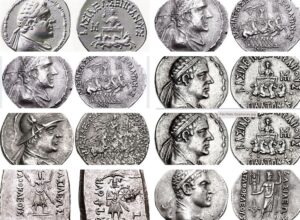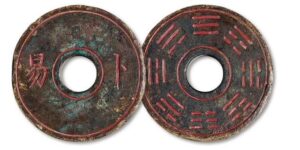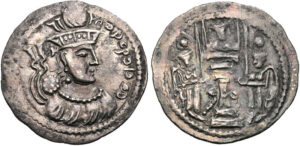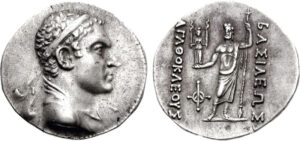
Coins of Bactrian Rulers courtesy Classical Numismatic Group, Inc. http://www.cngcoins.com
Theo Chan is the first son of a Hong Kong Real estate developer and his English wife. Theo went to private school in Hong Kong and then on to University at Cambridge in the United Kingdom. While he studied abroad, Theo learned about Western history and became fascinated with Greek civilization, particularly the Greco-Bactrian Kingdom which covered much of present-day Afghanistan, Uzbekistan, Tajikistan and Turkmenistan. When he returned home to Hong Kong after University, he started working with his father’s firm, and has engaged in a successful career overseeing the family properties not only in Hong Kong, but in Hawaii and Southern California. Like his father, he also married an English woman, and has children. Theo and his family split their time living at properties in Hong Kong, London, and Los Angeles.
As a child, Theo collected ancient Chinese Cash coins and British Colonial era coins from his native Hong Kong. As he grew older, he purchased ancient Chinese bronze artifacts that are displayed at his family’s office in Hong Kong. Recently, he returned to his interest in Ancient Greece by building up an important collection of ancient Greek coins, with a particular focus on large silver portrait tetradrachms of the Greco-Bactrian kingdom.

Chinese numismatic charms auctioned 2017 from the article “花錢 一 真實成交表” on the Taiwanese KKNews.cc website.
Theo is not alone. Not only Hong Kong, but all of China, has become a country of coin collectors. Chinese collectors purchase not only modern issues of the People’s Republic of China, but historic ancient and early modern coins, including those of foreign nations. There are five Chinese auction houses that serve the top of the numismatic market. China Guardian is the premier numismatic auction house with offices in Beijing, Shanghai, Guangzhou, Taipei, Tokyo, New York, and Vancouver. It specializes not only in coins but antiques and art. The others include Chengxuan Auction, EPAMA, Shanghai Hosane, and E&W International Auction. Of these, only E&W is State owned.
All the others have private ownership with varying links to the PRC’s Communist rulers. For example, the founder of China Guardian Auctions is married to Chairman Mao’s granddaughter. In addition, two American auctioneers, Heritage and Stack’s Bowers, conduct regular auctions of ancient and modern coinage in Hong Kong. And of course, Chinese buyers are welcome to bid abroad. Just recently, Baldwins celebrated a successful e-sale of Chinese cash coins that had been assembled by Sir William Ehrman, a British diplomat who served as Ambassador to China from 2006-2010. Presumably at least some of the successful bidders hail from Hong Kong or China.

Kidarites. Peroz. Circa 395-425. AR Drachm (25.5mm, 3.36 g, 3h). Gandhara mint E. courtesy Classical Numismatic Group, Inc. http://www.cngcoins.com
In addition to high-end auction houses, collectors can find all sorts of ancient and modern coins on-line, at local stores, at numismatic conventions, and in traditional markets. For example, LPM Group Limited is an e-seller of ancient and modern coins located in Hong Kong. It is currently running a special on ancient Athenian tetradrachms. On May 19-21, 2023, Beijing will host the China International Coin Expo. The Chinese Government views that show as so significant that it has even minted a series of 10-yuan silver commemorative coins depicting ancient Chinese, Greek, Roman, Byzantine, and Sassanian coins to mark the show’s opening. Other significant coin shows are held in Shanghai and Guangzhou. Finally, Liulichang in Beijing has been known as a traditional market for antiques, coins and artifacts since the Qing dynasty. It is just one of many traditional markets around the country where ancient and modern coins can be found.

Wang Mang Spade Money, Author Scott Semans.
The surge in collecting coins is just part of a much larger increase in the value of China’s art and collectible’s market. What began with state-owned antiquities stores launched after the end of the Cultural Revolution has expanded dramatically since the 1990s with the end of a planned economy and the creation of a market economy complete with auction houses, galleries, and an extensive internal trade in art, antiques and antiquities. Today, China’s art market is amongst the largest in the world. One accessible metric relates to the value of all art, antique and antiquities auctions in China. Since 2012 the annual turnover for domestic auctioneers on the mainland has been about CNY 30 billion (which is the equivalent of US $4.5 billion).
While Chinese coin collectors have traditionally tended to focus on ancient and modern Chinese coins, Chinese collectors have recently expanded their interests to coins that circulated in other nations. US based dealers have attributed recent large increases in the values of ancient Greek coins, particularly large, attractive silver tetradrachms, to new interest in such coins from Chinese buyers. Moreover, Chinese collectors are not the only ones purchasing ancient Greek, Roman, and Byzantine coins at auctions in the US and Europe. Indeed, one Swiss auction house recently reported that it had received 30,913 bids from 1,458 different bidders from 71 countries in one of its extensive web auctions of ancient Greek, Roman, Byzantine, and other coins. As people from Asia, the Middle East, Eastern Europe and Latin America get richer, some with a taste for history and collecting have taken advantage of the possibilities of internet commerce to build up collections of historic coins from their own culture or that of another like Ancient Greece.

The coins of Agathocles of Bactria (ruled 190–180 BCE), show Zeus holding Hecate in his hand, courtesy Classical Numismatic Group, Inc. http://www.cngcoins.com
And what about Theo? Well, he has almost completed his portrait collection of coins of Greco-Bactrian rulers. He hopes to loan it to a prominent museum in Hong Kong which is planning a major exhibit about the Silk Road. Part of him wonders though if it would be “safer” to have his collection stored at his homes in London or Los Angeles. As a member of Hong Kong’s elite, Theo constantly worries about how the political winds will blow in the coming years.
Next Edition: Collecting Bubbles that Burst.
Further reading:
On the Chinese Art Market
Chinese Art Market Report 2019, The European Fine Art Foundation (TEFAF).
On the Chinese Coin Market
Shen Chen and Zehua Cheng, Coin and China—A Comprehensive Chinese Coin Market Research Report, California State University (August 10, 2017).
[1] Peter K. Tompa has written extensively about cultural heritage issues, particularly those of interest to the numismatic trade. Peter contributed to Who Owns the Past?” (K. Fitz Gibbon, ed, Rutgers 2005). He formerly served as executive director of the Global Heritage Alliance and now is a member of its board of directors. This article is a public resource for general information and opinion about cultural property issues and is not intended to be a source for legal advice. Any factual patterns discussed may or may not be inspired by real people and events.
 Hong Kong Night Skyline, Base64, retouched by CarolSpears, 15 June 2008, Wikimedia Commons, CCA-SA 3.0 Unported License.
Hong Kong Night Skyline, Base64, retouched by CarolSpears, 15 June 2008, Wikimedia Commons, CCA-SA 3.0 Unported License. 

